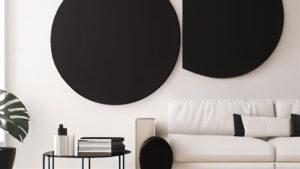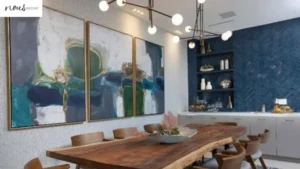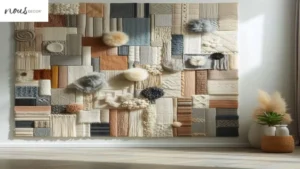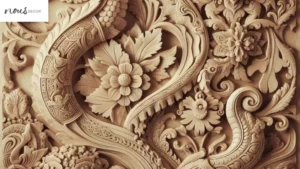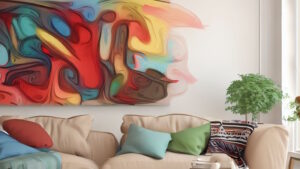In the world of interior design, hanging wall art is like adding a cherry on top of a perfectly baked cake. It’s that finishing touch that brings a room to life and adds depth and complexity to the space. But how high should you hang your precious artwork before considering it hanging too high? Should it be at eye level or higher?
Well, fear not, because I’m here to guide you through this artistic conundrum of How High To Hang Wall Art. Determining the perfect placement for your wall art involves considering factors like eye-level placement, the room’s function, furniture arrangement, visual balance, and even art sizes and styles.
So join me and Nousdecor on this journey as we delve into the intricacies of hanging wall art at just the right height. Get ready to transform your walls into captivating masterpieces that will leave everyone in awe!
Takeaways
- Hanging wall art at the right height is essential to achieving a balanced and visually appealing arrangement.
- How High To Hang Wall Art guides you through the process of determining the ideal positioning for your art pieces.
- Wall Art Placement involves selecting the most suitable wall and room for your artwork, ensuring it complements the overall decor.
- Understanding Artwork Sizing relates to the dimensions of your pieces and how they fit within your space, allowing you to create a harmonious display.
- Meanwhile, Framing and Matting impact the overall presentation, enhancing the visual appeal and integration with your decor.
- These considerations are crucial, but remember that Lighting Considerations, Gallery Walls, Art Installation Tools, and Personal Style and Aesthetics also affect your choices in achieving the perfect wall art display.
- By carefully considering these elements, you can create a personalized and aesthetically pleasing gallery that enhances your living space.
How High To Hang Wall Art: Perfect Height to Hang a Gallery Wall
When it comes to hanging decorative wall pieces, determining the proper height can be a challenge.
- To achieve eye-level placement, start by measuring 57-60 inches from the floor to the center of your picture. This rule applies to hanging a single piece of art or photographs on narrow walls.
- However, if you’re hanging a wall art on a large wall, the general guideline is to hang the top of your picture around 57-60 inches. By doing so, you create visual balance and symmetry in your home gallery.
- Additionally, when considering the room’s function and furniture placement, adjust the picture height accordingly. For example, if you have low seating in the room, you may need to hang your artwork slightly lower. Conversely, if you have tall furniture, the artwork may need to be hung a bit higher.
- Finally, when using multiple pieces to create a display wall, ensure each picture is hung at the proper height for its size and style, while still maintaining overall visual harmony.
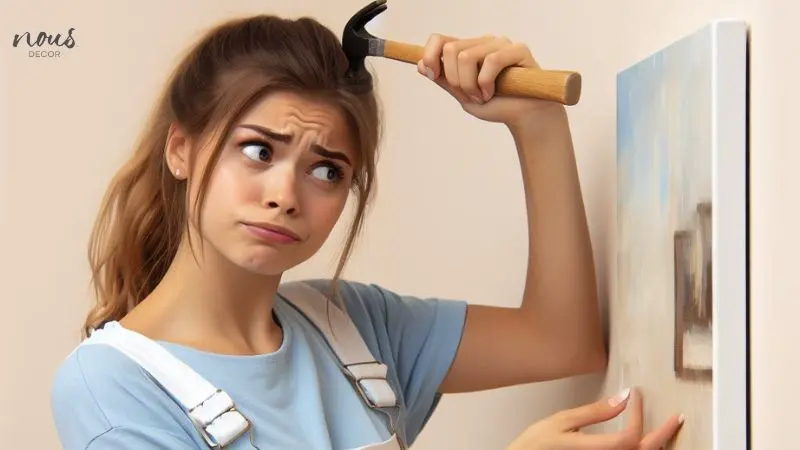
Determining the Eye Level Hanging Art Placement
Imagine standing in front of a beautiful piece of artwork like a coastal wall decor, trying to determine the perfect eye-level placement for hanging it on your wall. To achieve this, there are a few general rules of thumb to consider.
- First, use measuring techniques to ensure accuracy with the standard height formula. Start by measuring from 57 inches to 60 inches from the floor, which is considered the average artwork at eye level for most people.
- If the artwork is large or will be viewed primarily when seated, adjust accordingly. For example, your wall decor should be hung above furniture like the couch. Additionally, incorporating lighting into your decision is crucial.
- Consider how natural and artificial light sources interact with the artwork’s colors and textures when choosing its placement.
By taking these measurements and lighting considerations into account, you can create an optimal visual experience within your living room space. Now let’s move on to considering the room’s function and furniture placement seamlessly as we continue our quest for ideal art placement.
Creating Visual Balance and Symmetry To Hang Your Picture
To achieve a visually balanced and harmonious arrangement in your space, you can strategically position your furniture, consider the room’s lighting, and select wall colors that create a striking contrast with your carefully chosen artwork like plaster wall art.
- Color coordination plays a crucial role in creating an aesthetically pleasing display. By selecting art pieces that complement the room’s color scheme, you can create a cohesive look that groups everything together.
- Additionally, incorporating different textures in your wall art arrangements adds depth and interest to the overall design. Consider mixing materials like oil paintings, canvas prints, framed photographs, or even sculptural pieces to create visual variety. This combination of color coordination and texture will elevate your space and make it feel more curated.
Now let’s explore how using multiple pieces can transform your walls into stunning displays without overwhelming the space.
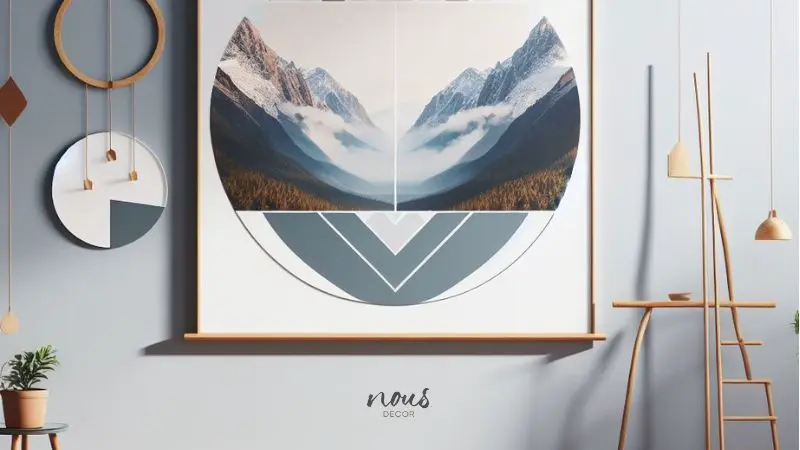
Considering the Room’s Function and Furniture Placement For Hanging Pictures
When considering the function of your room and where you’ve placed your furniture, it’s important to think about the perfect placement for your beautiful artwork, from big to small pictures. To ensure that your wall art enhances the overall aesthetic of the space without subtracting anything, consider the following factors for your wall:
- Room lighting: Take into account both natural and artificial lighting in the room. Make sure to hang your artwork away from direct sunlight to prevent fading, and consider adding additional lighting to highlight specific pieces.
- Wall color: The color of your walls can greatly impact how your artwork is perceived. Choose complementary colors or create a striking contrast between the artwork and the wall to make it stand out.
- Furniture placement: Consider the layout of your furniture when hanging art in your home. Aim for a visual balance by aligning the center of each piece with eye level while taking into account any nearby furniture or architectural features.
- Creating visual balance and symmetry: By carefully considering room lighting, wall color, and furniture placement symmetry, you can achieve a harmonious arrangement of artwork that creates visual balance and symmetry in your space.
With these considerations in mind, you can hang a picture and ensure that your wall art perfectly complements the function of your room and creates a visually pleasing atmosphere.
Using Multiple Pieces to Create a Gallery Wall for Hanging Artwork
Get ready to transform your walls into stunning displays by using multiple pieces of art in your home. When creating an art display, it’s important to choose complementary color palettes that harmonize with each other and the overall room decor.
Consider selecting artworks with similar hues or tones for a cohesive look. Additionally, incorporating different hanging techniques can add visual interest and depth to your wall collage. Mix and match frames, canvas prints, and even 3D objects for an eclectic touch.
Now that you have learned about using multiple pieces to create an art display such as the LG Art Cool Gallery, let’s move on to adjusting the height for different art sizes and styles, ensuring each piece gets its well-deserved spotlight without overpowering the others.
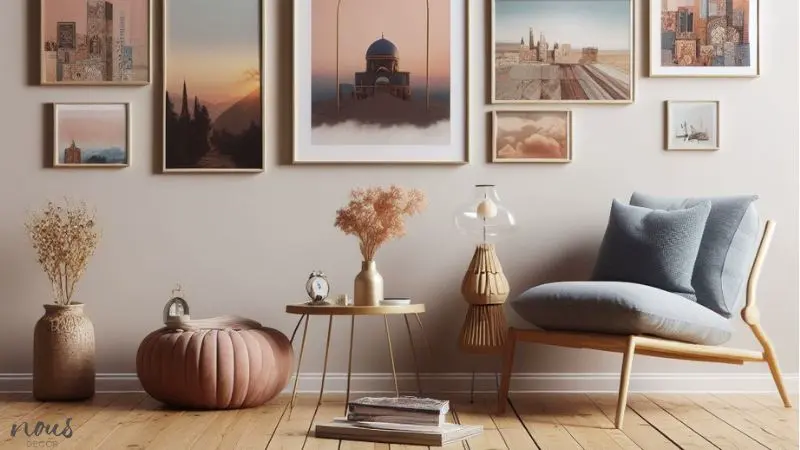
Adjusting the Picture Height for Different Art Sizes and Styles
Make sure you take into account the different sizes and styles of your artwork when adjusting their height on the wall so that each piece can shine individually while still being part of a cohesive gallery.
For example, imagine you have a large abstract painting as the centerpiece, surrounded by smaller black and white photographs in various frames, creating an eye-catching display that draws attention from every angle.
- Hanging oversized art: When it comes to hanging oversized art, consider placing it at eye level or slightly above to create a visually balanced composition. This will allow viewers to fully appreciate its grandeur without straining their necks.
- Choosing the right frame: The frame you choose can greatly enhance the overall look of your artwork. For larger pieces, opt for thicker and more substantial frames to complement their size and make a statement. Smaller artworks can benefit from delicate frames that add a touch of elegance without overpowering them from the bottom of the frame.
- Creating visual hierarchy: To create visual interest within your art display, vary the heights at which you hang your artwork. Place larger pieces higher up on the wall to draw attention first, then arrange smaller pieces around them to create a sense of balance and flow.
- Considering sight lines: When determining the height for different art sizes and styles, consider how they will interact with furniture or architectural features in the room. Hang taller pieces above sofas or tables so they are easily visible but don’t overwhelm the space, while shorter pieces can be placed lower on walls or clustered together for impact.
Frequently Asked Questions
Conclusion
In conclusion, achieving the correct height for hanging wall art is crucial for enhancing the overall aesthetic and ambiance of a room. By considering eye-level placement, the room’s function, furniture arrangement, lighting interaction, and creating visual balance and symmetry, you can create a visually pleasing and harmonious display.
- Remember to adjust the height for different art sizes and styles, allowing each piece to shine individually while complementing the others in a gallery arrangement. Mixing different styles and genres of art can add an eclectic and dynamic touch to your display.
- Lastly, to avoid wall damage when rearranging your art, opt for removable adhesive hooks or picture hanging strips. With these tips in mind, you can confidently turn your walls into captivating masterpieces that transform your living spaces and leave a lasting impression on anyone who enters.
So, unleash your creativity and let your walls become an artistic canvas for self-expression with this guide on How High To Hang Pictures!

